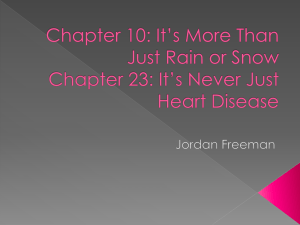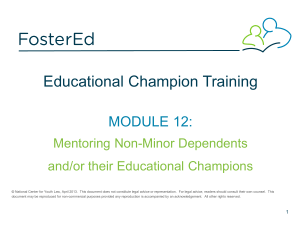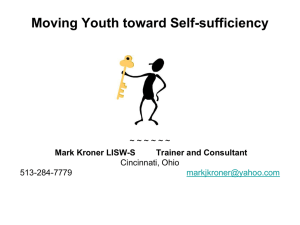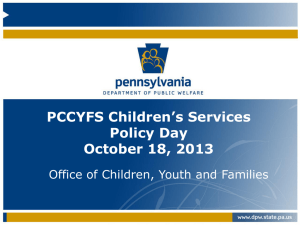Helping Foster Youth Heal and Thrive to Succeed
advertisement
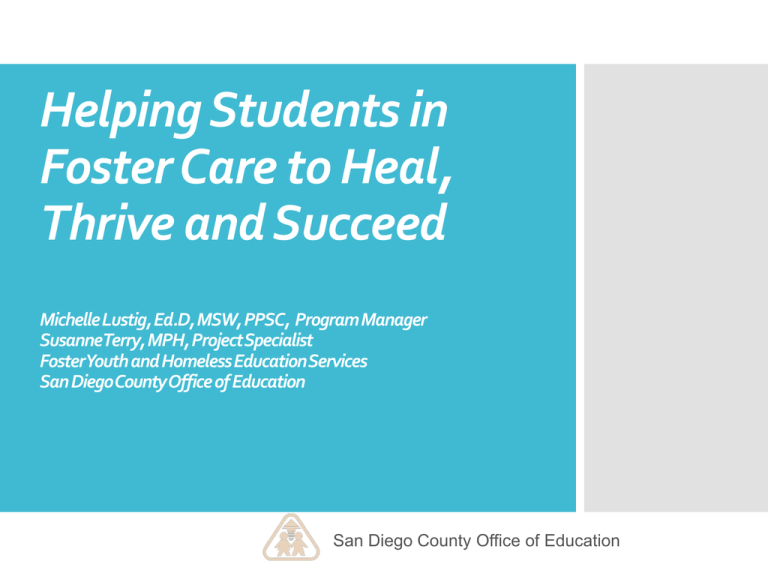
Helping Students in Foster Care to Heal, Thrive and Succeed Michelle Lustig, Ed.D, MSW, PPSC, Program Manager SusanneTerry, MPH, Project Specialist FosterYouth and Homeless Education Services San Diego County Office of Education San Diego County Office of Education COMMON GROUND: WHO ARE OUR CHILDREN? Every 40 seconds a child in this country is born into poverty. Every 11 seconds a child in this country is abused. Every day in California 100 children enter the foster care system. Every child in foster care is a member of our community and many are students in our classrooms. WHY DO EDUCATORS NEED TO KNOW ABOUT STUDENTS IN FOSTER CARE? The needs of students in foster care go largely unrecognized by public education because: School administrators and educators receive little or no information or training on the foster care system or on the impact of the foster care experience. Communication between the education and child welfare systems has been difficult historically. Public education is under tremendous pressure to increase AYP and API scores, so other issues fall to the wayside. LCFF and LCAP San Diego County Office of Education In 2013 California became the first State in the US to include students in foster care as a sub- group for accountability (API) Data will be available weekly based on a Statewide data match LCAP’s must include separate services and outcomes for students in foster care if there are over 15 students district wide. GROUND BREAKING RESEARCH ONTO THE EDUCATIONAL EXPERIENCES OF STUDENTS IN FOSTER CARE IN CALIFORNIA: The California Child Welfare Indicators Project in partnership with the Center for the Future of Teaching and Learning at WestEd. The Invisible Achievement Gap , Part 1: Education Outcomes of Students in Foster Care in California Public Schools (2013) The Invisible Achievement Gap, Part 2: How the Foster Care Experience of California Public School Students Are Associated with Their Educational Outcomes (2014) Both reports are available at : http://www.stuartfoundation.org/NewsAndReport s/ReportsAndResearch Students in foster care constituted an at-risk subgroup that was distinct from low-SES students. Students in foster care were more likely than other students to change schools during the school year. Primary Research Findings: Part 1 Students in foster care are more likely than the general student population to be enrolled in the lowest-performing schools and more likely to be enrolled in nontraditional schools. Students in foster care had the lowest participation rate in California’s statewide testing program. Statewide testing showed an achievement gap for students in foster care and other at-risk student groups High school students in foster care had the highest dropout rate and lowest graduation rate. Students in foster care had the lowest participation in California’s statewide testing program and participation was tied to placement instability. Primary Research Findings: Part 2 Statewide testing documented that the achievement gap for students in foster care was greatest in upper grade levels and for students who experienced three or more foster care placements. Among all high school students, those in foster care had the highest dropout and lowest graduation rates; students in more stable placements showed better performance for both of these education outcomes Students in every type of foster care placement experienced an achievement gap compared to their peers in school. Students in foster care: ADDITIONAL RESEARCH INTO EDUCATIONAL OUTCOMES FOR STUDENTS IN OUT OF HOME CARE HAS FOUND: have lower GPAs and lower standardized test scores, earn fewer credits toward HS graduation, are more likely to be exempted from state testing, only 56% of youth in care graduate from high school while in care, are more likely to be in special education programs, read (on average), at only a seventh grade level after completing 10th or 11th grade, experience (on average) 1 or 2 placement changes per year, over a third have reported having 5 or more school changes, studies show that only 13% of former foster youth go on to college versus 60% of all high school seniors. Only 3% will graduate from college. Is twice as likely to drop out of school. Is more likely to be suspended or expelled. A TYPICAL CHILD IN FOSTER CARE IN CALIFORNIA Will take 24 more months longer to graduate. Is more likely to receive a GED. Is less likely to be enrolled in A-G and AP courses. Will attend 5 or 6 different high schools achieve 2-3 years below their grade level. A TYPICAL CHILD IN FOSTER CARE WILL: Have a high incidence of clinical mental health diagnosis (54%). Battle social and emotional problems as a result of abuse and placement. Be medicated more often than their peers. Experience developmental delays well into adulthood. King County Superior Court (2005) 3 of 10 alumni become homeless post foster care. 27% of Males and 10% of females will be FOSTER CARE incarcerated. ALUMNI Alumni have a 30% higher likelihood of being OFTEN FACE substance abusers. A DIFFICULT ADULTHOOD: Alumni have a 50% higher likelihood of experiencing domestic violence. Alumni make up 75% of youth in the criminal justice system. -King County Superior Court 2005 Social Worker and/or Probation Officer Attorney/Guardian ad Litem WHO ARE THE KEY STAKEHOLDERS IN A STUDENT IN FOSTER CARE’S LIFE? Judge Caregiver: Biological Parent, Foster Parent, Relative Caregiver, Group Home Provider Judge Court Appointed Special Advocate (CASA)/Education Rights Holder Live in 10 different foster homes or group homes. A TYPICAL CHILD IN FOSTER CARE IN WILL: Often be separated from their siblings. Often be re-traumatized by the act of being placed. Experience even worse outcomes if they are youth of color. WHAT IS THE ROLE OF EDUCATORS? Teachers, principals, counselors, school social workers, psychologists, nurses, and directors of child welfare and attendance, are all critical stakeholders in the educational success of students in foster care. It is imperative that you have a firm understanding of the impact of trauma and the types of interventions that are potentially harmful and as well as those that are likely to be effective. Lets start with hope…. Resiliency is: “The Deep Belief that at one time you really mattered to another human being” Vincent Feletti, M.D. ADVERSE CHILDHOOD EXPERIENCES (ACES) Something happens between infancy and adulthood to create a lifetime of addictions, abuse and mental health problems. Source: Adverse Childhood Experiences (ACE) Study. Information available at http://www.cdc.gov/ace/index.htm Of 17,000 respondents, two-thirds had at least one adverse childhood event Physical, emotional or sexual abuse Emotional or physical neglect ADVERSE CHILDHOOD EXPERIENCES Growing up with family members with mental illness, alcoholism or drug problems Family violence Incarcerated family member One or no parents Parental divorce Source: Adverse Childhood Experiences (ACE) Study. Information available at http://www.cdc.gov/ace/index.htm Historical Trauma Evidence of post-traumatic stress disorder across generations Pregnant women impacted by the World Trade Center attacks on 9/11 who had PTSD from the event gave birth to babies with an elevated stress response and a hypersensitive stress axis. These babies will be more susceptible to anxiety, depression and even PTSD than those whose mothers who did not experience PTSD Of the 17,000+ respondents… More than 25% grew up in a household with an alcoholic or drug user ACE Study Findings 25% had been beaten as children Two-thirds had 1 adverse childhood event 1 in 6 people had four or more ACES Source: Adverse Childhood Experiences (ACE) Study. Information available at http://www.cdc.gov/ace/index.htm Untreated Adverse Early Childhood Events Only Exacerbate Over Time Source: Adverse Childhood Experiences (ACE) Study. Information available at http://www.cdc.gov/ace/index.htm Traumatized children are: ACEs & School Performance 2.5x more likely to fail a grade in school Score lower on standardized achievement tests More likely to have struggles in receptive and expressive language Suspended and expelled more often More frequently placed in special education 51% of children with 4+ ACE scores had learning and behavior problems in school ACEs Impacts Learning Compared with only 3% of children with NO ACE score Source: Burke, N.J., Hellman, J.L., Scott, B.G., Weems, C.F & Carrion, V.C. (June 2011). “The Impact of Adverse Childhood Experiences on an Urban Pediatric Population,” Child Abuse and Neglect, 35, No. 6. Trauma, Self-Regulation and Coping Skills: Information and Techniques to Help Children Overwhelming experience Involves a threat What is Traumatic Stress? Results in vulnerability and loss of control Leaves people feeling helpless and fearful Interferes with relationships and beliefs Source: Herman, J. (1992). Trauma and Recovery. New York Basic Books. Sources of Traumatic Stress Loss of a loved one Accidents Homelessness Community/School violence Witnessing of domestic violence Neglect Physical abuse Psychological abuse Sexual abuse Man-made or natural disasters Terrorism War The Stress Response: A Chemical One Prepares the body for action when threat is detected Helps the body respond to stress effectively Our Brain’s Trio Brain Stem: SAFETY/SURVIVAL (physical responses to perceived threat; starting with release of chemicals) Mid-Brain: EMOTIONAL CONNECTION (memories stored related to triggering incident) Cortex: EXECUTIVE STATE (problem solving, critical thinking skills- reading, writing, & arithmetic) Body’s response to danger: • Fight • Flight • Freeze The Stress Response and Trauma Overwhelms a person’s usual ability to cope. Varied responses. Most recover. Some develop more severe difficulties. Triggers include seeing, feeling, or hearing something that remind us of past trauma. Triggers Triggers activate the alarm system. When the alarm system is activated, but there is no danger, it is a false alarm. The response is as if there is current danger. Toxic stress from exposure to violence can impair healthy development One study revealed that exposure to relationship-based violence and trauma in the first two years of life resulted in lower IQ scores at 5 and 8 years of age. Enlow MB, Egland B, Blood EA, Wright RO, & Wright RJ (April 4, 2012) Interpersonal trauma exposure and cognitive development in children to age 8 years: a longitudinal study. Journal of Epidemiology and Community Health Online First. Skills specific to each developmental stage build on learning from previous stages. Development and Trauma Children exposed to trauma invest energy into survival instead of developmental mastery. Development in adulthood may continue to be impacted. “Trauma can be a single event, connected series of traumatic events or chronic lasting stress.” Diagnostic Classification: 0-3R Child Welfare and Trauma Children in the child welfare system almost by definition have suffered trauma, often multiple traumatic events, and 50-75% exhibit behaviors or symptoms that need mental health treatment. Source: Landsverk, Burns, Stambaugh, & Rolls Reutz (2009). Psychosocial Interventions for Children and Adolescents in Foster Care: Review of Research Literature. Child Welfare, 88 (1), 49-69. SelfRegulation “The growth of self-regulation is a cornerstone of early childhood development that cuts across all domains of behavior.” From: Neurons to Neighborhoods, p. 26. In other words, it is the ability to balance self-control with self-expression. Refers to attention, behaviors and emotions Examples of SelfRegulation: Establishing sleep-wake patterns Increasing attention span Focusing on a goal Managing emotions appropriately and in context Expressing feelings constructively “Two by Ten” Strategy R. Smith & M. Lambert, Assuming the Best The Brain In The Palm of the Hand: Teaching SelfRegulation Brainstem: Mid-brain: Cortex: Pre-frontal Cortex: Wrist, Palm Thumb Fingers over Thumb Fingernails Use and Teach what you know about trauma: Handouts: Jody McVittie, MD, Sound Discipline Self-Regulation is a Predictor of Academic Success Belonging & Significance: Relationships Matter Children need to feel belonging & significance before we can really expect them to respond or care about our rules or limits Healthy relational interactions with safe and familiar individuals can buffer and heal trauma related problems Research shows social connectedness as a protective factor against maltreatment Social milieu (safe environments): major mediator of trauma • Safety: physical and emotional safety Structure: predictable, consistent routines Creating an Atmosphere for Learning Supervision: eyes, ears, proximity to students Self-Regulation: model it/teach it Sense of Belonging & Significance (SelfEsteem): “I can do this; I belong here” Success-celebrate! In or out of the classroom Teach life skills Pay attention to the power of perception (illogical beliefs, world view) Focus on encouragement (empowering vs. enabling) Some Basic Tools from Alfred Adler: Hold the tension of kindness and firmness at the same time (firm limits and nurturance concurrently) Look to mutual respect: Respect for yourself and the situation: firmness Respect for the child and others: kindness Assume mistakes to be an opportunity to learn Look to solutions rather than punishment Biology of trauma impacts ability to regulate (Brain Trio, survival mode) Trauma, SelfRegulation & Coping Skills Summing It Up Trauma impacts the caregiver-child relationship (Worldview; attachment) To heal, children must feel safe in their bodies and they must have supportive relationships with loving caregivers (TEACHERS) who they can trust (Relationships Matter! Creating an Atmosphere for Learning) If coping skills are more developed, a child is much better equipped to handle stress (Model and Teach Self-Regulation)


